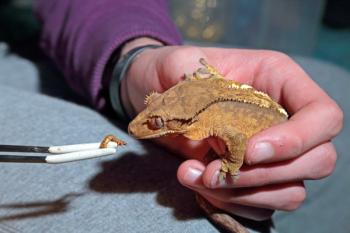
Insectivores and herbivores alike need variety to get maximum nutrients
Mitchell received a DVM and an MS in wildlife epidemiology from the University of Illinois in 1992 and 1997, respectively. He completed a PhD in wildlife epidemiology at Louisiana State University in 2001. He has spent his entire career working as a professor of zoological medicine at these 2 institutions and
has authored more than 800 book chapters, peer-reviewed articles, scientific abstracts, proceedings, and lay articles. He is a past president (2000-2001) of the Association of Reptilian and Amphibian Veterinarians, a former coeditor in chief of the Journal of Exotic Pet Medicine (2005-2019), a former editor-in-chief of the Journal of Herpetological Medicine and Surgery (2009-2021) and currently servs as editor in chief of the Journal of Avian Medicine and Surgery (2021-present). Mitchell is also the first recipient of the ARAV Excellence Award (2016).

Insectivores and herbivores alike need variety to get maximum nutrients

Endocrine diseases in ferrets have been attributed to genetics, early-age neutering, diet, and photoperiod.

When an exotic small mammal presents for a problem associated with the integument, it may be hard not to try to focus on that specific system.

The rise in popularity of herpetoculture over the past two decades has led to an increased number of reptiles being imported and captive reared to meet the demands of herpetoculturists.

Diagnostic imaging is an underutilized resource in herpetological medicine.

Many of the exotic species we deal with have evolved to mask their illness to avoid predation.

Nontraditional mammalian species, such as ferrets, lagomorphs, marsupials, hedgehogs, and rodents, are stoic by nature and have evolved to mask their illness to avoid predation.

The majority of the exotic pet cases presented to veterinarians are dehydrated as a result of a chronic disease.

With the growing popularity of exotic pets in the United States, the incidence of zoonotic diseases attributed to these pets should be expected to rise.

Marsupials have some of the most unique anatomic and physiologic features among members of the Class Mammalia.

The majority of the reptile cases presented to veterinarians are dehydrated as a result of a chronic disease.

Parasites are a common finding in wild-caught and captive small exotic mammals.

Clinicians working with "exotic species" should establish consistent anesthetic and analgesic protocols to manage cases that require diagnostic or surgical procedures.

Many of the exotic species we deal with have evolved to mask their illness to avoid predation.

Ferrets remain popular pets in the United States.

There are two ways to approach a disease issue in fish: 1) ante-mortem tests and 2) post-mortem tests.

Bearded dragons (Pogona spp.) are omnivorous lizards that are native to Australia.

Published: April 1st 2009 | Updated:

Published: April 1st 2009 | Updated:

Published: April 1st 2009 | Updated:

Published: April 1st 2009 | Updated:

Published: April 1st 2009 | Updated:

Published: April 1st 2009 | Updated: